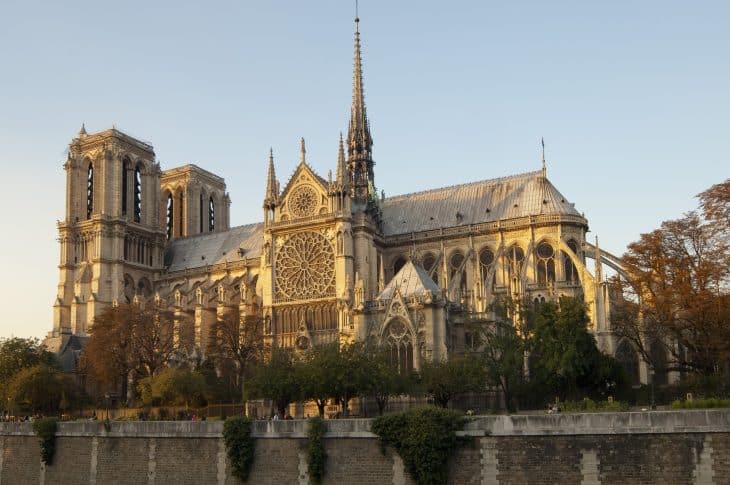
In April 2019, news of the Notre Dame fire alarmed the whole world. It compelled great amounts of donations from various individuals and organizations. However, the fire is not the only thing that makes the famous Notre-Dame de Paris as remarkable as it is. Learn more about how the Notre Dame stood the test of time through these Notre Dame Cathedral facts.
- 01The construction of the Notre Dame Cathedral took almost 200 years from 1163 to 1345.
- 02The Notre Dame Cathedral is 128 m (420 ft) high and 12 m (39 ft) wide.
- 03Around 13 million visitors flock to the Notre Dame Cathedral annually.
- 04An estimated 52 acres of forest were cut down for the construction of the cathedral’s wooden frame.
- 05As of June 2020, the Notre Dame Cathedral is 857 years old.
- 01Also called Notre Dame Cathedral, the Notre-Dame is a cathedral church in Paris.
- 02The name Notre Dame translates to ‘Our Lady of Paris’ in English.
- 03It serves as the seat of the archbishop of Paris.
- 04The Notre Dame Cathedral is a ‘jewel’ of medieval Gothic architecture.
- 05Its construction system bears masonry and cut stone.
- 06Of the Middle Ages, the Notre-Dame de Paris is the most famous Gothic cathedral.
- 07The distinction of the structure comes mainly from its antiquity, size, and architectural interest.
- 08The largest bell in the cathedral can be found in the South Tower.
- 09Named the Emmanuel Bell, it weighs 13 tons or 28,000 pounds.
- 10Access is free of charge during the cathedral’s opening hours.
- 01In 1431, Henry VI of England was crowned king of France in Notre-Dame de Paris.
- 02In 1804, the same place witnessed the crowing of Napoleon Bonaparte as emperor.
- 03Pope Pius X beatified Joan of Arc in the cathedral in 1909.
- 04The Notre Dame Cathedral was the safe place of the crown of thorns and the tunic of Saint Louis.
- 05It beat the Eiffel Tower in being the most popular monument not just in Paris, but in all of France.
Notre Dame Cathedral Facts Infographics
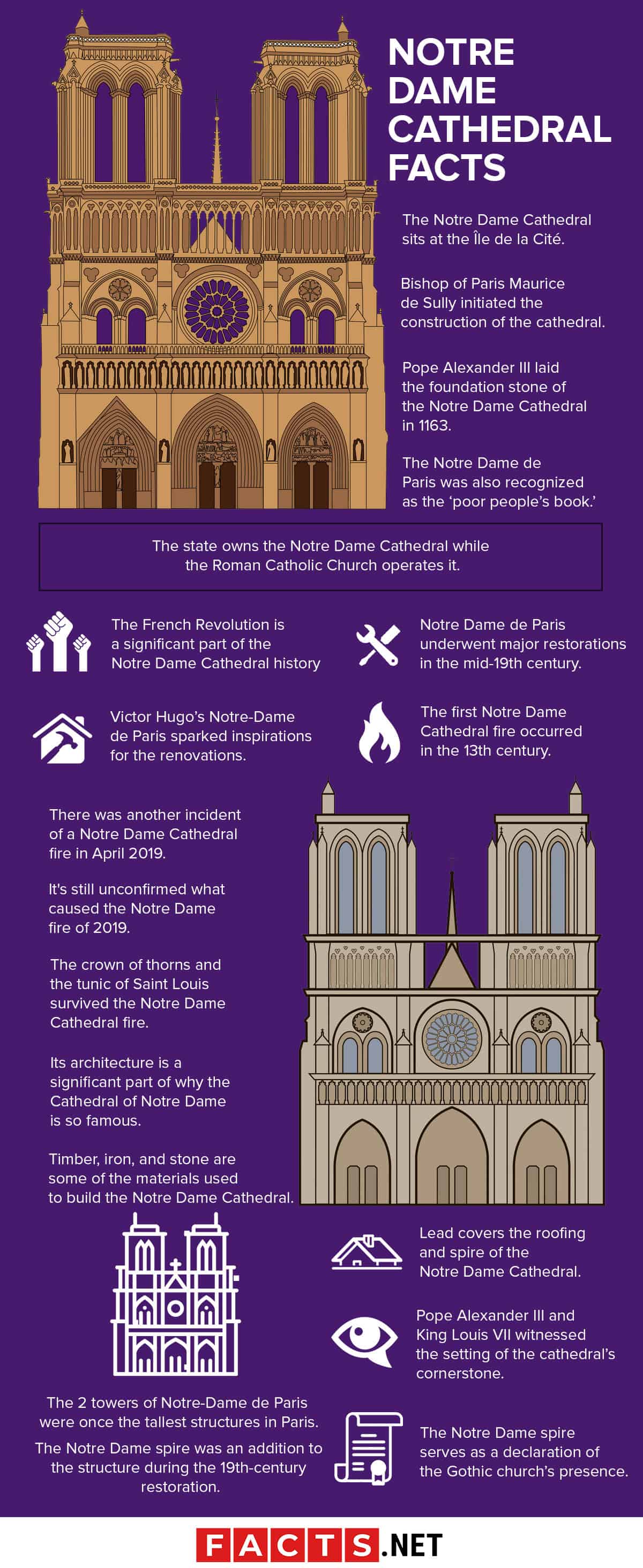
The Notre Dame Cathedral sits at the Île de la Cité.
At the eastern end of the river island, in the middle of the Seine lies the Notre Dame Cathedral built on the ruins of two older churches. Prior to its construction, a Gallo-Roman temple devoted to Jupiter predates these two churches.
Bishop of Paris Maurice de Sully initiated the construction of the cathedral.
The Bishop of Paris first proposed the concept of converting two older basilicas into a single building. The end result was the replacement of the decrepit cathedral of Saint-Étienne and the 6th-century Notre-Dame. Moreover, it introduced the new approach of a Gothic style.
Pope Alexander III laid the foundation stone of the Notre Dame Cathedral in 1163.
The consecration of the high altar followed in 1189. By 1250, the nave, the choir, and the western facade added into the construction. Eventually, the chapels, porches, and other embellishments completed the cathedral over the following 100 years.
The state owns the Notre Dame Cathedral while the Roman Catholic Church operates it.
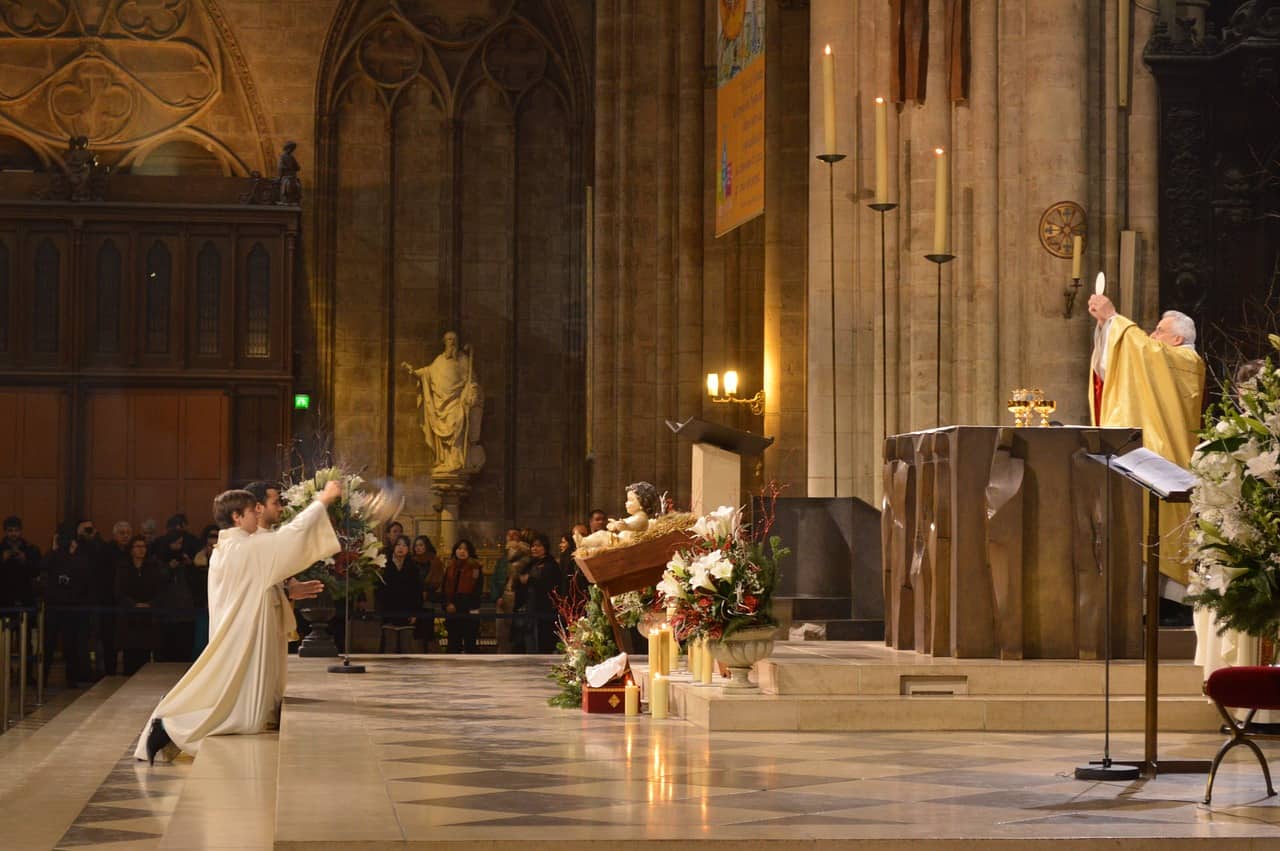
Notre Dame Cathedral shares this similarity with all the other cathedrals in France. Moreover, the church handles paying the bills and wage for employees without French government subsidies. Definitely one of the Notre Dame Cathedral facts to remember.
The Notre Dame de Paris was also recognized as the ‘poor people’s book.’
Among the many inspirations for the appearance of the basilica is the goal to share the story of Christianity to the illiterate classes of the city. With the heavily painted and gilded sculptures in and out of the Notre Dame Cathedral, the storytelling style of its architecture is prominent.
Not only did it catch the attention of people from around the world, but it also reminded them of God’s laws. It might as well be one of the reasons why the cathedral of Notre Dame is so famous.
The French Revolution is a significant part of the Notre Dame Cathedral history.
The medieval Catholic cathedral has faced many damages through centuries of its existence. However, the damage that it acquired during the French Revolution reached the point where the building was put up for auction to a building-materials merchant.
Napoleon Bonaparte made history when he annulled the auction sale of the Notre Dame.
When Napoleon I came to power, one of his first steps in leadership was to annul the sale of the cathedral. Then, he ordered for the redecoration of the place where he later had his coronation as emperor in 1804.
King Louis-Philippe initiated the restoration of the church that was neglected earlier during the French Revolution in 1790.
Notre Dame de Paris underwent major restorations in the mid-19th century.
French architects Eugène-Emmanuel Viollet-le-Duc and Jean-Baptiste-Antoine Lassus worked from 1845 to 1864 to restore the cathedral. Part of their project was redoing the spire and the flying buttresses.
Victor Hugo’s Notre-Dame de Paris sparked inspirations for the renovations.
Published in 1831, the popular historical novel had the medieval cathedral as its setting. It divulged the decrepit condition of the structure as well. Eventually, the book was published in English as ‘The Hunchback of Notre Dame.’ You can relive the old Notre Dame for yourself here.
The first Notre Dame Cathedral fire occurred in the 13th century.
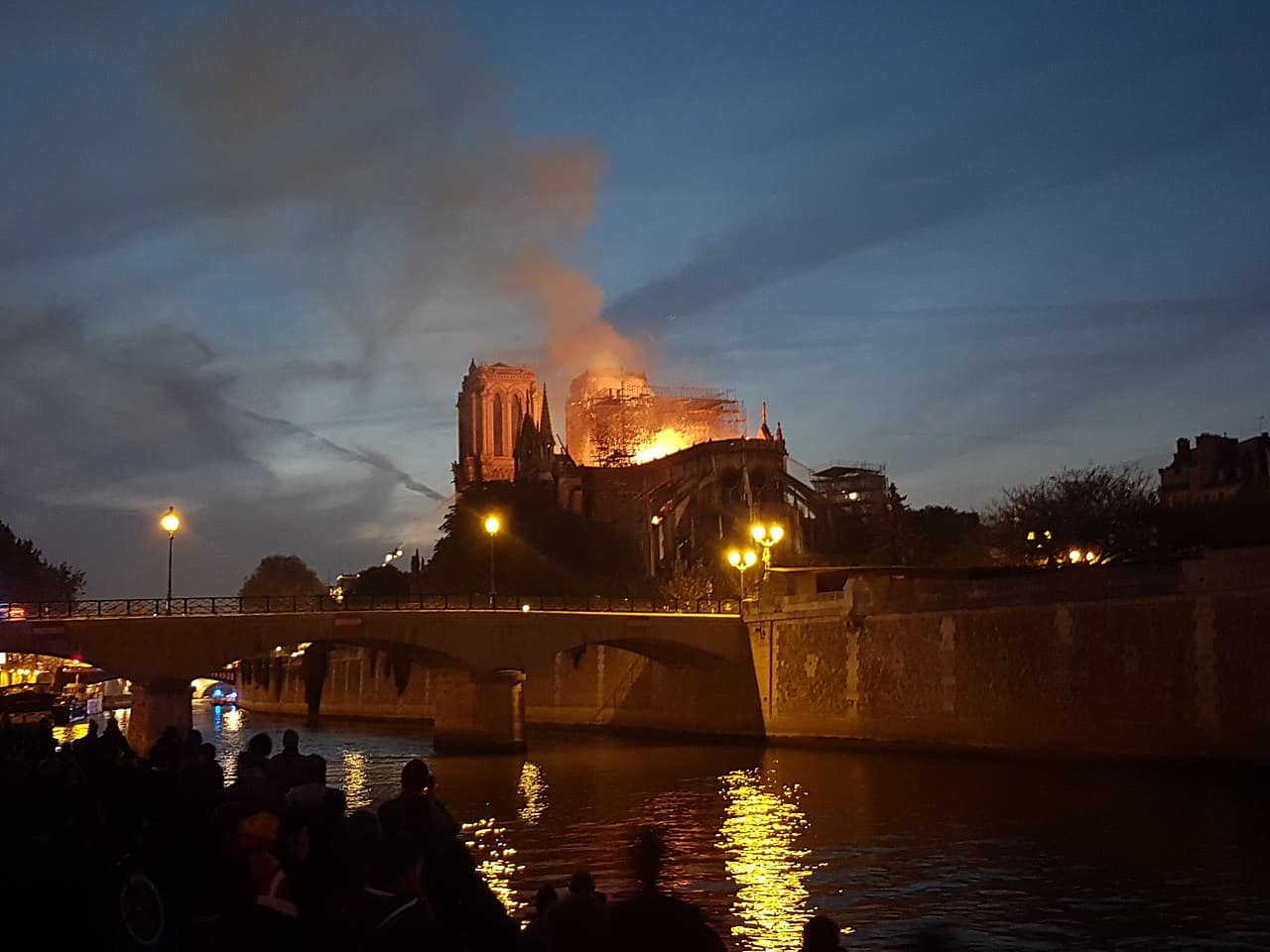
This means that the present edifice of the historical site is already a replacement of an older church damaged by fire. As written in the book The Engineering of Medieval Cathedrals, this incident prompted additional work on the structure in 1230 to 1240.
There was another incident of a Notre Dame Cathedral fire in April 2019.
The fire tragically broke out in the attic of the medieval Catholic cathedral. Unfortunately, this most recent fire ravaged most of the roof and some of the rib vaulting. Even the 19th-century spire installed by architect Eugène-Emmanuel Viollet-le-Duc was not spared. Definitely one of the more unfortunate Notre Dame Cathedral facts.
It's still unconfirmed what caused the Notre Dame fire of 2019.
The investigation has spanned two months, involving testimony trials of 100 witnesses. Still, the city’s public prosecutor’s office announced two leading theories on what caused the Notre Dame Cathedral fire. One was an improperly extinguished cigarette while the other was an electrical short circuit.
The crown of thorns and the tunic of Saint Louis survived the Notre Dame Cathedral fire.
France’s cultural minister Franck Riester declared that the relics made it safely to the Paris City Hall. Before being kept at the cathedral, the crown first had the Ste. Chapelle in Ile de la Cité as its home. Furthermore, this crown has the reputation of being the same one that Jesus Christ wore during the crucifixion.
Its architecture is a significant part of why the Cathedral of Notre Dame is so famous.
The Gothic sculptures and glass art of the structure are well-known for their naturalism as well. Moreover, this style is a depiction of the evolution and transition of Romanesque architecture and sculpture.
Timber, iron, and stone are some of the materials used to build the Notre Dame Cathedral.
Each beam that formed the basilica’s wooden roof structure was made from a different oak tree from 800 years ago. Hence, it bore the moniker ‘The Forest.’ Meanwhile, the stone used to build the cathedral came from the underground quarries dug beneath the 5th and 12th arrondissements.
Pope Alexander III and King Louis VII witnessed the setting of the cathedral’s cornerstone.
This architectural term refers to the first stone of Notre Dame. With these Notre Dame Cathedral facts, the wide recognition of the structure’s importance is proven.
Lead covers the roofing and spire of the Notre Dame Cathedral.

Unfortunately, most of this material dating back to the 19th century melted in the 2019 fire. The same material also forms some of the internal sealing that holds the stained-glass panels.
The Notre Dame spire was an addition to the structure during the 19th-century restoration.
In the 18th century, renovations included the complete removal of the original Notre Dame spire due to instability. Thus, builders fitted a new central spire as part of the restoration. Other important parts of the medieval Catholic cathedral are the apse and choir, a short transept, and a nave. Double aisles and square chapels flank the nave on either side.
The Notre Dame spire serves as a declaration of the Gothic church’s presence.
Aside from its size allowing it to be admired from a great distance, this part also advertised the institution’s connection to heaven. People also believe that the famed spire provides a close association with picturesque eclecticism.
The 2 towers of Notre-Dame de Paris were once the tallest structures in Paris.
With 387 steps and a height of 69 meters, the Notre Dame initially towered over the City of Love. However, the completion of the Eiffel Tower immediately grabbed the title from it. The construction of these towers came last among the major elements of the cathedral.
The Notre Dame Cathedral towers aren't equal in size.
One of the commonly mistaken Notre Dame Cathedral facts is that its towers stand in equal height. However, one is actually larger than the other. The towers are a representation of architecture’s evolution over centuries of the cathedral’s constructions, repairs, and reconstruction.
All the bells of the Notre Dame Cathedral have specific names.
Currently, there are ten bells installed. Their names are Anne Genevieve, Benoit-Joseph, Denis, Emmanuel, Etienne, Gabriel, Jean-Marie, Marcel, Marie, and Maurice.
The Notre Dame Cathedral interior measures 130 x 48 meters (427 x 157 feet) in the plan.
Meanwhile, the roof reaches a height of 35 meters or 115 feet. The western facade is crowned by the two massive early-Gothic towers. Moreover, this part has three stories with doors bearing fine early-Gothic carvings and rows of Old Testament kings figures.
The iconic Notre Dame rose window was the only part to retain its 13th-century glass.
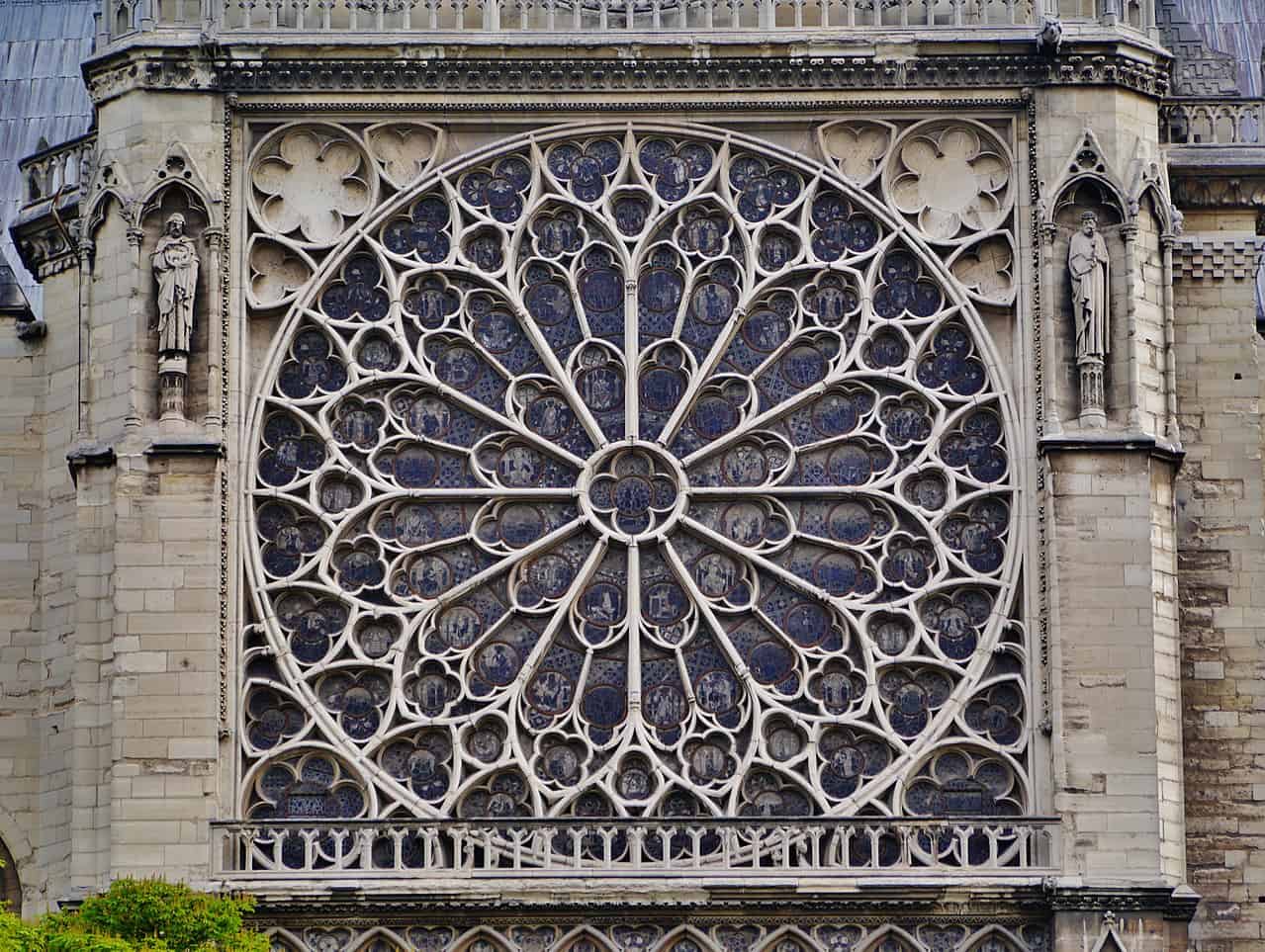
The apse at the cathedral’s east end has large clerestory windows added between 1235 and 1270. Supporting the apse are single-arch flying buttresses which bore more daring Rayonnant Gothic style recognized for their grace and boldness.
The west Notre Dame rose window is the smallest among the other roses.
Located over the portals, it was the first one installed as well. The three rose windows, above the other stained-glass windows, are among the most renowned features of the cathedral.
The west Notre Dame rose window measures only 9.6 meters in diameter.
It was installed in 1225 using pieces of glass set in a thick circular stone frame. Unfortunately, none of the original glass of the window remained as it was renovated in the 19th century.
The flying buttresses of Notre Dame de Paris are not mere decorations.
Aside from its contribution to the cathedral’s Gothic style, these features also provide support to the structure. It was particularly designed to help hold the thin, tall walls up and prevent cracks from forming in them.
The Notre Dame Cathedral used flying buttresses for both the nave and the choir.
As common features of Gothic architecture, the buttresses are masonry elements consisting of half arches supporting inclined beams. The arches projects from structure walls to a pier, thus supporting the weight and horizontal thrust of a dome, roof, or vault.
These flying buttresses are capable of bearing flyers as well. When the chapels joined the vicinity, the choir buttresses got extensions of about 1.5 meters.
The Notre Dame Cathedral gargoyles are more than just decorations, too.
After the rain, these gargoyles divide the pouring water torrent from the roof then projects it outwards. This way, they spew out water streams as far as possible from the buttresses, walls, and windows. These are the most fragile parts of the Notre Dame since the mortar binding the stone can possibly erode.
By the 21st century, the Notre Dame damage became more evident.
Causes include prolonged weather exposure and decades of acid rain damage. With such significant compromise on the cathedral’s exterior stonework, the French government subsequently spent millions of Euros annually on its maintenance and restoration.
Was this page helpful?
Our commitment to delivering trustworthy and engaging content is at the heart of what we do. Each fact on our site is contributed by real users like you, bringing a wealth of diverse insights and information. To ensure the highest standards of accuracy and reliability, our dedicated editors meticulously review each submission. This process guarantees that the facts we share are not only fascinating but also credible. Trust in our commitment to quality and authenticity as you explore and learn with us.
